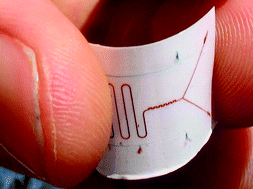In this article we present a new versatile replication method to produce thin polymeric microfluidic devices with tunable porosity. This method is based on phase separation of a polymer solution on a microstructured mold. Compared to existing microfabrication techniques, such as etching and hot embossing, our technique offers four advantages: (a) simple and cheap process that can be performed at room temperature outside clean room facilities; (b) very broad range of applicable materials (including materials that could not be processed before); (c) ability to make thin flexible chips; (d) ability to introduce and tune porosity in the chip. By introducing porosity, the channel walls can be used for selective transport of gasses, liquids and solutes. A proof-of-concept will be given, by showing fast CO2 transport through the channel walls of a porous polymer chip. Furthermore, it will be demonstrated that the gas permeation performance of chips can be enhanced dramatically by a decrease in chip thickness and incorporation of porosity. We expect that the development of porous chips can lead to the on-chip integration of multiple unit operations, such as reaction, separation, gas liquid contacting and membrane emulsification.

You have access to this article
 Please wait while we load your content...
Something went wrong. Try again?
Please wait while we load your content...
Something went wrong. Try again?


 Please wait while we load your content...
Please wait while we load your content...